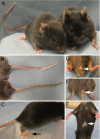Mice with mutations of Dock7 have generalized hypopigmentation and white-spotting but show normal neurological function
- PMID: 19202056
- PMCID: PMC2650330
- DOI: 10.1073/pnas.0813208106
Mice with mutations of Dock7 have generalized hypopigmentation and white-spotting but show normal neurological function
Abstract
The classical recessive coat color mutation misty (m) arose spontaneously on the DBA/J background and causes generalized hypopigmentation and localized white-spotting in mice, with a lack of pigment on the belly, tail tip, and paws. Here we describe moonlight (mnlt), a second hypopigmentation and white-spotting mutation identified on the C57BL/6J background, which yields a phenotypic copy of m/m coat color traits. We demonstrate that the 2 mutations are allelic. m/m and mnlt/mnlt phenotypes both result from mutations that truncate the dedicator of cytokinesis 7 protein (DOCK7), a widely expressed Rho family guanine nucleotide exchange factor. Although Dock7 is transcribed at high levels in the developing brain and has been implicated in both axon development and myelination by in vitro studies, we find no requirement for DOCK7 in neurobehavioral function in vivo. However, DOCK7 has non-redundant role(s) related to the distribution and function of dermal and follicular melanocytes.
Conflict of interest statement
The authors declare no conflict of interest.
Figures




References
-
- Baxter LL, Hou L, Loftus SK, Pavan WJ. Spotlight on spotted mice: A review of white spotting mouse mutants and associated human pigmentation disorders. Pigm Cell Res. 2004;17:215–224. - PubMed
-
- Tachibana M, Kobayashi Y, Matsushima Y. Mouse models for four types of Waardenburg syndrome. Pigm Cell Res. 2003;16:448–454. - PubMed
-
- Bennett DC, Lamoreux ML. The color loci of mice—a genetic century. Pigm Cell Res. 2003;16:333–344. - PubMed
-
- Di Pietro SM, Dell'angelica EC. The cell biology of Hermansky-Pudlak syndrome: Recent advances. Traffic. 2005;6:525–533. - PubMed
-
- Shiflett SL, Kaplan J, Ward DM. Chediak-Higashi Syndrome: A rare disorder of lysosomes and lysosome related organelles. Pigm Cell Res. 2002;15:251–257. - PubMed
Publication types
MeSH terms
Substances
Grants and funding
LinkOut - more resources
Full Text Sources
Medical
Molecular Biology Databases
Miscellaneous

